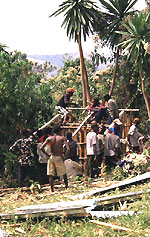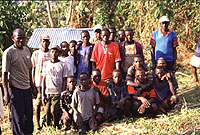| Period: 1 January - 31 March 2003. Country: Ethiopia |
| (1) Contextualizing the Process of Pottery Making: Artisan
Group Among Ari in Southwestern Ethiopia |
| KANEKO Morie (Division
of African Area Studies) |
| Key Words: Pottery, Forming
Techniques by Hands, Women Artisan Group, Learning Process,
Creativity |

Building the tomb |

Relatives of Ms. A's husband bulit the tomb |
(2) In the Ari Area of southwestern Ethiopia,
there are at least three characteristics describing the use, manufacture,
and exchange of pots: 1) The Ari people use several kinds of pots
in their daily life as cooking utensils; 2) pottery makers in the
Ari area make pots using local clay; and 3) they sell their pots to
consumers directly in local markets without using brokers.
Focusing
on these three characteristics, I set up three objectives for this
research. 1) Describing how Ari people use several kinds of pots separately,
and how pottery makers make pots, focusing on the movements involved
in the production process. 2) Discovering the characteristics of the
relationships, such as users and makers, makers and their relatives,
and makers' group associations. 3) Describing the process of the diffusion
of the different kinds of pots into the Ari area through communications
with other ethnic groups. After achieving these objectives, I try
to describe the technological, social, economic, and political relationships
in terms of the use, manufacture, and exchange of pots in the Ari
area.
(3) The Ari people belong to
three social groups, kantsa, gashimana, and mana.
The members of the kantsa and gashimana groups
work mainly in farming. The members of the mana group are
engaged in making commodities such as pots, wood works, and iron
works. These three groups are not only separated by their professions,
but also prohibited from intermarriage, performing funerals (in
particular, kantsa people refused to bury mana
people because of "impurity"), and eating together, even
in informal situations. I have reported on the process of raising
problems in terms of these social prohibitions among three groups,
as well as the process of negotiations for solving this problem.
1) When a certain pottery maker
passed away, the members of the mana mutual association
group and mutual association group did not promptly bury her.
A certain pottery maker (A) and her husband (B)
did not belong to the mana mutual association group.
All the pottery makers in their village had gradually converted
to Protestantism more than 20 years earlier. The group was called
a Protestant mutual association group rather than a mana
mutual association group. A and B had not converted to Protestantism,
and sometimes had quarrels with group members about group activities.
A and B had been members of the kantsa mutual association
group since 1999.
2) The leader of the Protestant mutual association
group accepted B's request that group members perform A's funeral.
B asked the kantsa group to perform A's
funeral as an exception, but they refused his request. B finally
decided to ask the Protestant group to bury A. He promised the
leader that he would pay a fine to the association group. This
leader went to the leader of kantsa mutual association
group to explain why B should withdraw from their group. After
this process, A's funeral was performed.
3) The Protestant association group finally
accepted members who believed local religion because B belonged
to the kantsa association group, whose members faced serious
social prohibitions.
After B joined this group, others who belonged to
mana but had not converted to Protestantism also joined.
The members of the group consist of Protestants, both gashimana,
and mana people who believe in local religion. They call
this group by the village name, wachamer mutual association group.
|


 21st Century COE Program
-Aiming for COE of Integrated Area Studies-
21st Century COE Program
-Aiming for COE of Integrated Area Studies-